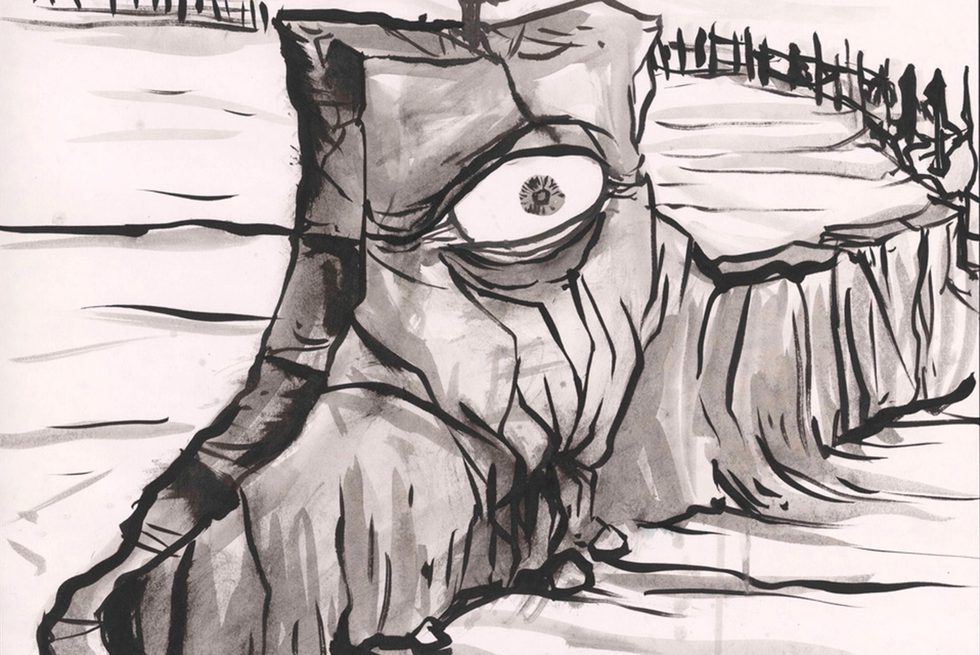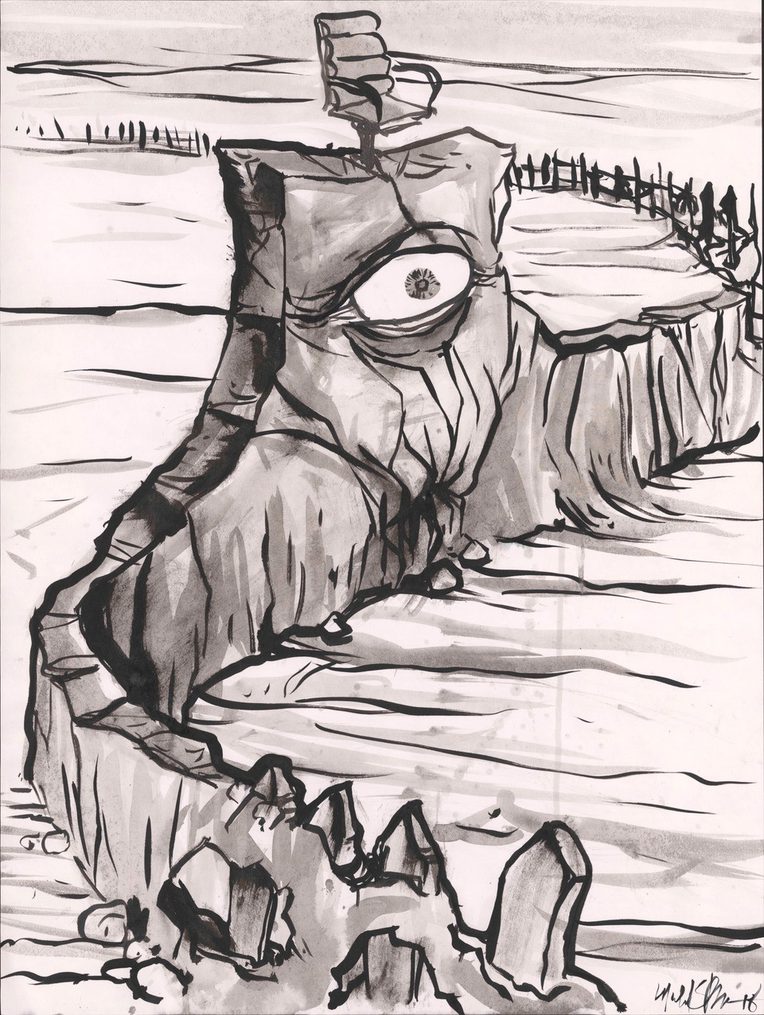The Wall
From the Series: Time of Monsters
From the Series: Time of Monsters

There is a poem called “The Picket Fence” (Der Lattenzaun), by Christian Morgenstern:
One time there was a picket fence
With space to gaze from hence to thence.An architect who saw this sight
approached it suddenly one night,removed the spaces from the fence,
and built of them a residence.

The poem ends:
The picket fence stood there dumbfounded
with pickets wholly unsurrounded,a view so loathsome and obscene,
the Senate had to intervene.The architect, however,
flew to Afri- or Americoo.
I keep misremember the ending. I keep thinking that the fence gets up and walks away. The resolution by the aesthete Senate is unconvincing: surely not in Americoo. I know the reason for my misremembering. Michel de Certeau mentions this poem on the same page on which he notes that in fables, the voice of the frontier cannot but be enunciated by animals. “‘Stop,’ says the forest the wolf comes out of. ‘Stop!’ says the river, revealing its crocodile” (de Certeau 1984, 127). It is not a stretch to say that the border, whether in fable or in between states, takes on a life of its own. We cannot decide whether it is a mere figure within a given ground or that which defines the ground itself. Self-grounding and “unsurrounded,” it is like a creature with the power of Creation: a monster, according to Christian theology (Santner 2006). A monster has no need for its “architect.” It is fitting that the poem sends the architect into perpetual exile.
The monstrous mirroring of opposites—creature/Creator—that borders inspire is well captured in the Old Testament tale about the word shibboleth (Judges 12:6). The Ephraimites are fleeing from the Galatians after their defeat. They are stopped at the Galatian checkpoint at the border, at the passage that crosses the Jordan River. The fugitives pretend to be Galatians. But the guards have just the right test for them: the word shibboleth, which the Ephraimites tend to pronounce “sibboleth.” On failing the test, the text relates: “They would take him and kill him at the shallow crossings of the Jordan.”
The last sentence always takes my breath. I can think of two reasons. One, there is the deliberate pace of the cruel, serial operation: one-by-one, as if no tally is necessary. This laborious repetition imposes on the reader the task of having to recover each time anew. One dies alone here, alone with the executioner. My horror resides in this repetitive, intimate paring. This mirroring of the executioner and his victim. And this perverse pairing—which is the second reason—is spatially made even more perverse as the victims are taken to the very passage which promised them their safety.
Many a thinker has dwelled on this terrible story for insights into the nature of sovereign power. Jacques Derrida speaks to my first reason for horror, reflecting on the test that binds the would-be victim and the killer. “Sheltering in readability,” Derrida writes (2005, 26), the word shibboleth pairs the tester and the tested in the simultaneous operations of hiding and exposing. But whose sheltering? Both opposites, of course. The reason why the border forces opposites to share a shelter is made lucid in Giorgio Agamben’s (2008) analysis of the same tale. Agamben focuses on the topological structure of the passageway, which at once opens (toward escape, life) and closes. In this “zone of indistinction” (Agamben 2008, 4), the killer and the killed are not opposites but correlatives. The power of the Ephraimite consists in dis/simulating as a Galatian beside oneself; that of the Galatian guard, in taking the exposed dis/simulator outside the border—that is, to the passageway—precisely in order to delimit it. Both powers are produced in the act of self-othering. Sovereignty can only be evidenced, its border drawn body by body, by way of mirroring the dis/simulating power of the would-be trespasser.
Agamben (2008, 13) extends this “logic of sovereignty” to modern biopolitics. This rings true when we think about modern-day border crossings between states. Still, the power of the Wall subsists on the power of mobility enfolded within the traveling being. Dis/simulation abounds here. After all, what is the passport if not that which upstages and problematizes the body in presentation (in person and in photo), one individuated body at a time? And consider what textually accompanies the passport photo. A freely moving body is one self-authorizing its own movement. The passport’s narrative seal of approval dislocates that authority elsewhere by, as the poem has it, “removing the spaces.” The monster that results is what some call bare life.
The translation of Christian Morgenstern’s poem reproduced above is by Max Knight.
Agamben, Giorgio. 1998. Homo Sacer: Sovereign Power and Bare Life. Translated by Daniel Heller-Roazen. Stanford, Calif.: Stanford University Press. Originally published in 1995.
de Certeau, Michel. 1984. The Practice of Everyday Life. Translated by Steven Rendall. Berkeley: University of California Press. Originally published in 1980.
Derrida, Jacques. 2005. “Shibboleth: For Paul Celan.” In Sovereignties in Question: The Poetics of Paul Celan, edited by Thomas Dutoit and Outi Pasanen, 1–64. New York: Fordham University Press.
Santner, Eric. 2006. On Creaturely Life: Rilke, Benjamin, Sebald. Chicago: University of Chicago Press.